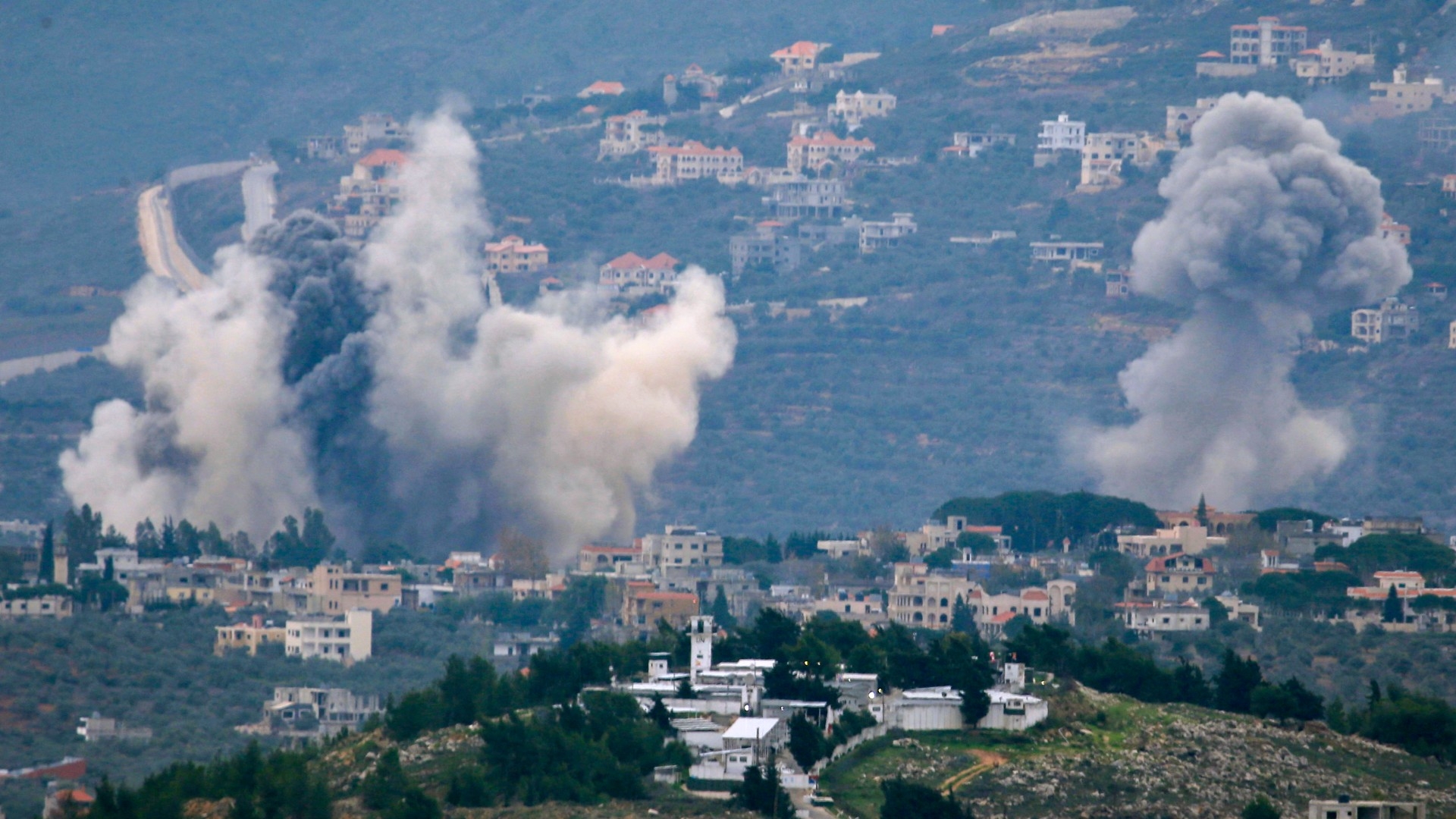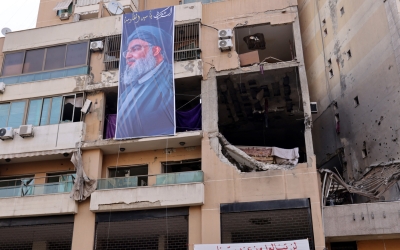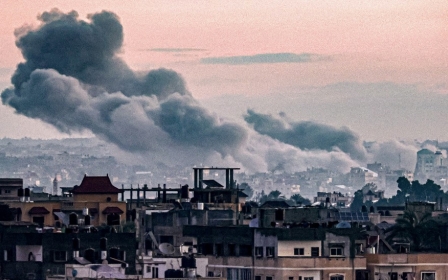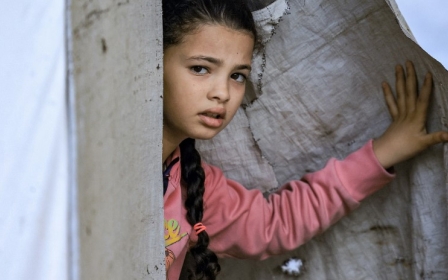Gaza 100 days on: Could Hezbollah's 'strategic restraint' prevent war with Israel?

This weekend marked one hundreds days since Israel's war on Gaza.
For the past three months, Lebanon's southern borders have been turned into a war zone between the Lebanese group Hezbollah and Israel since 8 October.
Recent developments leading up to the 100-day mark have marked a significant escalation in the long-standing conflict. The most notable incidents include Israel’s assassinations this month of key Hamas and Hezbollah leaders on Lebanese soil, including Hamas deputy Saleh al-Arouri and senior Hezbollah commander Wissam al-Tawil.
In a retaliatory move, Hezbollah responded with a drone attack on Israel’s northern command, just days after targeting an Israeli air base at Mount al-Jarmaq. These critical events signify a notable shift in the dynamics of the northern front, highlighting an intensifying war of strategic messaging and brinkmanship.
Arouri’s killing marked a critical juncture. The assassination was carried out during rush hour in Beirut’s densely populated southern suburb of Dahiyeh, which is considered to be a security zone for Hezbollah. Despite the risks of operating in such a crowded and sensitive location, Israel fired six high-precision missiles towards a building where Arouri was meeting with associates.
New MEE newsletter: Jerusalem Dispatch
Sign up to get the latest insights and analysis on Israel-Palestine, alongside Turkey Unpacked and other MEE newsletters
This decisive action came amid Israel’s urban warfare efforts in the Gaza Strip, where it has struggled to meet its goals of targeting the top leadership of Hamas, which is proscribed as a terrorist organisation in the UK and other countries. The successful Beirut operation, followed swiftly by Tawil’s killing in southern Lebanon, may be perceived as an attempt by the Israeli government to demonstrate its operational capabilities and to address perceived shortcomings in Gaza.
These assassinations had layered messages. To Hezbollah, they showed Israel’s military prowess and intelligence capabilities, evident in the elimination of high-profile targets. At the broader Lebanese societal level, the strike in Dahiyeh not only showcased Israel’s military precision, but it also evoked memories of the 2006 war. This act likely aimed to instil a sense of fear among civilians, who form a crucial support base for resistance movements.
The location and nature of Arouri’s assassination also holds significant implications for Lebanese domestic politics, reigniting contentious debate over the presence of Palestinian military elements on Lebanese soil, and the complexities arising from their protection and support by Lebanese factions.
It’s noteworthy, however, that Israel’s recent focus on hitting military targets on Lebanese territory, while minimising broader civilian casualties, avoids a larger-scale escalation. This signals a measured approach in Israel’s military strategy.
Calculated approach
For Hezbollah, while inflicting casualties on the Israeli military can be seen as a tactical gain, the group’s recent actions suggest a different primary objective. Notably, by hitting Israel’s northern command around 10 kilometres from the border - seen as one of Hezbollah’s deepest penetrations into northern Israel - the group has indicated a shift in focus.
The strike on Israel’s Meron air base is also significant in this regard. The base, known as the “eye of Israel”, has a wide surveillance range covering parts of Lebanon, Syria, Palestine and Jordan. It’s known as one of the most crucial military bases in the Middle East.
Follow Middle East Eye's live coverage of the Israel-Palestine war
Since the start of the war these strategic choices by Hezbollah reflect a calculated approach. Rather than aiming primarily to cause casualties, they seem to be more about demonstrating the group’s ability to target highly secured and strategically important Israeli military installations. This sends a message, challenging the perceived security of these sites and showcasing Hezbollah’s reach and military sophistication.
The pattern of retaliation after the assassinations of Arouri and Tawil reflects what Iranian Supreme Leader Ayatollah Ali Khamenei terms “strategic patience”. This approach, endorsed by Hezbollah, suggests a deliberate avoidance of immediate, uncalculated responses.
While both parties project an image of readiness and strength, there seems to be a mutual understanding of the high stakes and potential losses
In his first address after the 7 October attack, Hezbollah leader Hassan Nasrallah said Israel’s regional enemies were not at a stage where they could strike a decisive victory against the occupation, but rather were in a phase of “accumulating points” against their adversary.
"We are in a battle of resilience, patience and accumulation of achievements and points".
Nasrallah has, on more than one occasion, asserted Hezbollah’s readiness to engage in all-out war with Israel, underlining that such a conflict would have no red lines. In his last speech Nasrallah made it clear that the party has been ready to engage in a war for 99 days. However, Hezbollah’s current actions indicate a commitment to the group’s actual capabilities, and a clear understanding of its strategic position. They are carefully balancing what they can realistically achieve against their broader objectives.
There is an argument that Israel’s targeted operations on Lebanese soil aim to provoke Hezbollah into a broader conflict, potentially embarrassing the group in front of its supporters. But Hezbollah seems aware that Israel could benefit from drawing it into full-scale war.
By adhering to its current strategy, Hezbollah seems to be deliberately avoiding offering Israel the opportunity for such escalation. This points to strategic restraint on Hezbollah’s part, and an understanding of the larger geopolitical implications of an expanded confrontation.
Sober assessment
Meanwhile, the escalating situation in southern Lebanon can largely be seen as stemming from the lack of a viable political settlement in the region.
In his latest address, Nasrallah offered what he views as a potential resolution, proposing that current tensions could present an opportunity for the liberation of disputed Lebanese territories, such as Shebaa Farms and Ghajar village. But he was emphatic that such negotiations could not commence without a complete cessation of hostilities in the Gaza Strip.
This assertion gains added significance considering the recent visit of senior White House adviser Amos Hochstein to Beirut, set against a backdrop of heightened regional tensions. Such visits could play a pivotal role in shaping the future course of any negotiations.
Monitoring media outlets on both sides of this conflict reveals the vigilant watch each is keeping over the other. Both sides, while declaring the other reluctant to escalate into full-scale war, assert their own readiness to engage in conflict if provoked. These sentiments are rooted in a realistic assessment of the situation.
On one hand, Hezbollah is acutely aware of Israel’s capacity to inflict significant damage on Lebanese people and infrastructure, drawing parallels to recent events in Gaza, where Israel seems to operate with considerable international leeway.
On the other hand, Israel, despite its proclamations of readiness for a comprehensive war on the northern front, appears less eager for such escalation. This hesitancy likely stems from its current military commitments in Gaza and a sober assessment of its strategic position.
This stance is corroborated by a recent confidential US report, which suggests that Israel would be unlikely to achieve a decisive victory against Hezbollah on a second front. In essence, while both parties project an image of readiness and strength, there seems to be a mutual understanding of the high stakes and potential losses involved in all-out conflict, leading to a cautious approach by both.
The views expressed in this article belong to the author and do not necessarily reflect the editorial policy of Middle East Eye.
Middle East Eye delivers independent and unrivalled coverage and analysis of the Middle East, North Africa and beyond. To learn more about republishing this content and the associated fees, please fill out this form. More about MEE can be found here.






